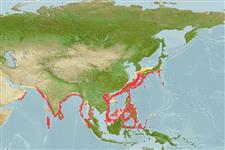Environment: milieu / climate zone / depth range / distribution range
นิเวศวิทยา
เกี่ยวกับทะเล,น้ำเค็ม สัตว์น้ำหน้าดิน; ระดับความลึก 100 - ? m (Ref. 114953). Tropical; 42°N - 0°N, 55°E - 143°E (Ref. 114953)
Indo-West Pacific; Oman (Arabian Sea) to north-east Asia (China and Japan).
ขนาด / น้ำหนัก / Age
Maturity: Lm ? range ? - ? cm
Max length : 18.0 cm TL เพศผู้/กระเทย; (Ref. 9913); common length : 20.0 cm TL เพศผู้/กระเทย; (Ref. 114953)
Found in continental waters, both inshore and offshore (Ref. 9913). Mainly feeds on crustaceans and polychaetes (Ref. 114953). Biology little known (Ref. 9913) but reported to produce 4-6 young each gestation (Ref. 114953). Adult males and females known at 15 cm TL; common size reported to reach 35 cm TL (Ref. 114953). The electric organs present on disc are used to stun the prey.
Life cycle and mating behavior
Maturities | การสืบพันธุ์ | Spawnings | Egg(s) | Fecundities | ตัวอ่อน
Compagno, L.J.V. and P.R. Last, 1999. Narkidae. Sleeper rays. p. 1443-1446. In K.E. Carpenter and V.H. Niem (eds.) FAO identification guide for fishery purposes. The living marine resources of the Western Central Pacific. FAO, Rome. (Ref. 9913)
IUCN Red List Status (Ref. 130435)
Human uses
การประมง: มีการค้าเพียงเล็กน้อย
เครื่องมือ
Special reports
Download XML
แหล่งที่มาจากอินเตอร์เน็ต
Estimates based on models
Preferred temperature (Ref.
123201): 19 - 28.2, mean 26.4 °C (based on 992 cells).
Phylogenetic diversity index (Ref.
82804): PD
50 = 0.6252 [Uniqueness, from 0.5 = low to 2.0 = high].
Bayesian length-weight: a=0.01000 (0.00244 - 0.04107), b=3.04 (2.81 - 3.27), in cm total length, based on all LWR estimates for this body shape (Ref.
93245).
ระดับชั้นอาหาร (Ref.
69278): 3.2 ±0.3 se; based on size and trophs of closest relatives
ความสามารถในการกลับคืนสู่ปกติ (Ref.
120179): ต่ำ, เวลาต่ำสุดที่จะทำให้ประชากรเพิ่มขึ้นเป็น 2 เท่าใช้เวลา 4.5 - 14 ปี (Assuming fecundity<100).
Fishing Vulnerability (Ref.
59153): Low vulnerability (10 of 100).
